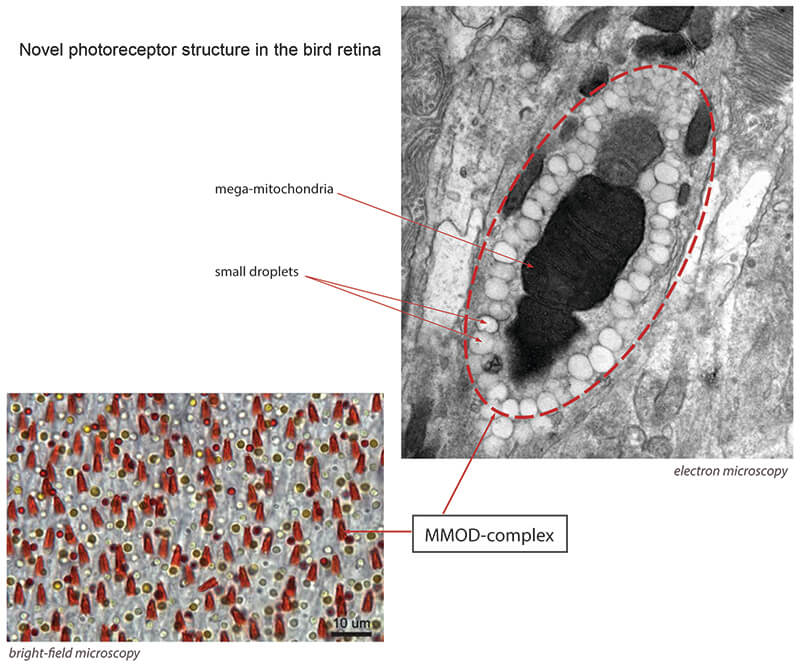December 16, 2019
Newly discovered retinal structure may enhance vision for some birds
 These microscopy images show a newly discovered retinal structure, called the MMOD-complex, in small sit-and-wait songbirds called flycatchers. (Purdue University image/ Esteban Fernandez-Juricic and Luke Tyrrell)
Download image
These microscopy images show a newly discovered retinal structure, called the MMOD-complex, in small sit-and-wait songbirds called flycatchers. (Purdue University image/ Esteban Fernandez-Juricic and Luke Tyrrell)
Download image
WEST LAFAYETTE, Ind. – A newly discovered retinal structure in the eyes of certain kinds of songbirds might help the animals find and track insect prey more easily.
The foundation of avian vision rests on cells called cone and rod photoreceptors. Most birds have four cone photoreceptors for color vision, a fifth cone for non-color-related tasks, and a rod for night vision. Each cone photoreceptor cell contains a spherical structure called an “oil droplet,” which filters light before it is converted to electrical signals by the visual pigments, enhancing color discrimination.
However, the researchers have discovered a never-before-seen type of cone structure in the retina of a group of small songbirds, called flycatchers. Instead of an oil droplet, it contains a high- energy-producing cellular structure called “megamitochondria” surrounded by hundreds of small, orange-colored droplets. The researchers named this novel cellular structure a megamitochondria-small oil droplet complex, or MMOD-complex.
The discovery, made at Purdue University, is detailed in a paper that appeared in the journal Scientific Reports, as part of a collaboration with the State University of New York at Plattsburgh, the University of Wisconsin-Madison, and the University of California, Davis.
The researchers studied this retinal structure using light microscopy, transmission electron microscopy and a technique called microspectrophotometry, which measures the wavelengths of light that these structures absorb the most. The MMOD-complex works as long-pass filters, letting light with wavelengths longer the 565 nanometers – or yellow, orange and red – pass through, and absorbing the shorter wavelengths of green, blue and violet.
Traditional cones were present throughout the retina of these flycatchers, and their density decreased moving away from the center toward the periphery. However, the MMOD-complex photoreceptors were present only in the central region of the retina, an arrangement that could help birds detect flying insects, said Esteban Fernandez-Juricic, a professor of biological sciences at Purdue.
“The retina of flycatchers, which are sit-and-wait predatory birds, evolved a novel cellular structure in a photoreceptor that may allow them to detect, track and capture fast-moving prey, like insects,” he said.
The paper’s lead author was Luke Tyrrell, a former Purdue doctoral student and now an assistant professor of biological science at SUNY Plattsburgh.
“This new cone organelle has not been reported before in this form in any other vertebrate retina and may allow these birds to see their world in a different way from other animals,” Tyrrell said.
A complete listing of the paper’s authors is available in the abstract, and the paper is available online here. The research was funded by the National Science Foundation. Future research will be aimed at establishing the function of this structure and assess the ability of flycatchers to catch prey under different ambient light conditions.
Writer: Emil Venere
Media contact: Steve Tally, 765-494-9809, steve@purdue.edu, @sciencewriter
Source: Esteban Fernandez-Juricic, 765-494-6044, efernan@purdue.edu
ABSTRACT
A novel cellular structure in the retina of insectivorous birds
Luke P. Tyrrell1*, Leandro B. C. Teixeira2, Richard R. Dubielzig2, Diana pita3, Patrice Baumhardt3, Bret A. Moore4 & Esteban Fernández-Juricic3
1SUNY Plattsburgh, Department of Biological Sciences, 101 Broad Street, Plattsburgh, NY, 12901, USA. 2University of Wisconsin-Madison, Department of Pathobiological Sciences, School of Veterinary Medicine, 2015 Linden Drive, Madison, WI, 53706, USA. 3Purdue University, Department of Biological Sciences, 915 W State Street, West Lafayette, IN, 47904, USA. 4University of California-Davis, William R. Pritchard Veterinary Teaching Hospital, School of Veterinary Medicine, 1 Garrod Drive, Davis, CA, 95695, USA. *email: ltyrr002@plattsburgh.edu
The keen visual systems of birds have been relatively well-studied. the foundations of avian vision rest on their cone and rod photoreceptors. Most birds use four cone photoreceptor types for color vision, a fifth cone for achromatic tasks, and a rod for dim-light vision. The cones, along with their oil droplets, and rods are conserved across birds – with the exception of a few shifts in spectral sensitivity – despite taxonomic, behavioral and ecological differences. Here, however, we describe a novel photoreceptor organelle in a group of New World flycatchers (Empidonax spp.) in which the traditional oil droplet is replaced with a complex of electron-dense megamitochondria surrounded by hundreds of small, orange oil droplets. the photoreceptors with this organelle were unevenly distributed across the retina, being present in the central region (including in the fovea), but absent from the retinal periphery and the area temporalis of these insectivorous birds. of the many bird species with their photoreceptors characterized, only the two flycatchers described here (E. virescens and E. minimus) possess this unusual retinal structure. We discuss the potential functional significance of this unique sub-cellular structure, which might provide an additional visual channel for these small predatory songbirds.
Note to Journalists: The paper is available online at https://www.nature.com/articles/s41598-019-51774-w or by contacting Steve Tally at 765-494-9809, steve@purdue.edu.

